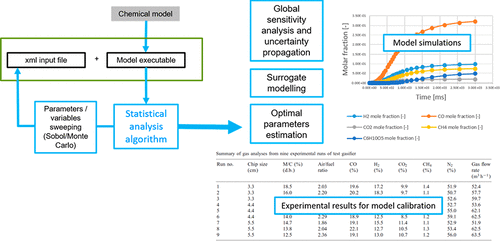当前位置:
X-MOL 学术
›
Energy Fuels
›
论文详情
Our official English website, www.x-mol.net, welcomes your
feedback! (Note: you will need to create a separate account there.)
Automated Advanced Calibration and Optimization of Thermochemical Models Applied to Biomass Gasification and Pyrolysis
Energy & Fuels ( IF 5.2 ) Pub Date : 2018-06-14 00:00:00 , DOI: 10.1021/acs.energyfuels.8b01007 Nicola Bianco 1 , Manosh C. Paul 2 , George P. E. Brownbridge 1 , Daniel Nurkowski 1 , Ahmed M. Salem 2 , Umesh Kumar 2 , Amit N. Bhave 1 , Markus Kraft 3, 4
Energy & Fuels ( IF 5.2 ) Pub Date : 2018-06-14 00:00:00 , DOI: 10.1021/acs.energyfuels.8b01007 Nicola Bianco 1 , Manosh C. Paul 2 , George P. E. Brownbridge 1 , Daniel Nurkowski 1 , Ahmed M. Salem 2 , Umesh Kumar 2 , Amit N. Bhave 1 , Markus Kraft 3, 4
Affiliation

|
This paper presents a methodology that combines physicochemical modeling with advanced statistical analysis algorithms as an efficient workflow, which is then applied to the optimization and design of biomass pyrolysis and gasification processes. The goal was to develop an automated flexible approach for the analyses and optimization of such processes. The approach presented here can also be directly applied to other biomass conversion processes and, in general, to all those processes for which a parametrized model is available. A flexible physicochemical model of the process is initially formulated. Within this model, a hierarchy of sensitive model parameters and input variables (process conditions) is identified, which are then automatically adjusted to calibrate the model and to optimize the process. Through the numerical solution of the underlying mathematical model of the process, we can understand how species concentrations and the thermodynamic conditions within the reactor evolve for the two processes studied. The flexibility offered by the ability to control any model parameter is critical in enabling optimization of both efficiency of the process as well as its emissions. It allows users to design and operate feedstock-flexible pyrolysis and gasification processes, accurately control product characteristics, and minimize the formation of unwanted byproducts (e.g., tar in biomass gasification processes) by exploiting various productivity-enhancing simulation techniques, such as parameter estimation, computational surrogate (reduced order model) generation, uncertainty propagation, and multi-response optimization.
中文翻译:

用于生物质气化和热解的热化学模型的自动化高级校准和优化
本文提出了一种将理化建模与高级统计分析算法相结合的方法,作为一种有效的工作流程,然后将该方法应用于生物质热解和气化过程的优化和设计。目标是开发一种自动化的灵活方法来分析和优化此类流程。此处介绍的方法也可以直接应用于其他生物质转化过程,并且通常还可以应用于可使用参数化模型的所有那些过程。最初制定了该过程的灵活的物理化学模型。在此模型中,将识别敏感模型参数和输入变量(过程条件)的层次结构,然后将其自动调整以校准模型并优化过程。通过基本的过程数学模型的数值解,我们可以了解所研究的两个过程中反应堆内物质的浓度和热力学条件如何变化。控制任何模型参数的能力所提供的灵活性对于实现过程效率及其排放的优化至关重要。它允许用户通过利用各种可提高生产率的模拟技术(例如参数估算)来设计和操作灵活的原料热解和气化过程,精确控制产品特性,并最大程度地减少有害副产物(例如生物质气化过程中的焦油)的形成。计算代理(降阶模型)生成,不确定性传播和多响应优化。
更新日期:2018-06-14
中文翻译:

用于生物质气化和热解的热化学模型的自动化高级校准和优化
本文提出了一种将理化建模与高级统计分析算法相结合的方法,作为一种有效的工作流程,然后将该方法应用于生物质热解和气化过程的优化和设计。目标是开发一种自动化的灵活方法来分析和优化此类流程。此处介绍的方法也可以直接应用于其他生物质转化过程,并且通常还可以应用于可使用参数化模型的所有那些过程。最初制定了该过程的灵活的物理化学模型。在此模型中,将识别敏感模型参数和输入变量(过程条件)的层次结构,然后将其自动调整以校准模型并优化过程。通过基本的过程数学模型的数值解,我们可以了解所研究的两个过程中反应堆内物质的浓度和热力学条件如何变化。控制任何模型参数的能力所提供的灵活性对于实现过程效率及其排放的优化至关重要。它允许用户通过利用各种可提高生产率的模拟技术(例如参数估算)来设计和操作灵活的原料热解和气化过程,精确控制产品特性,并最大程度地减少有害副产物(例如生物质气化过程中的焦油)的形成。计算代理(降阶模型)生成,不确定性传播和多响应优化。











































 京公网安备 11010802027423号
京公网安备 11010802027423号